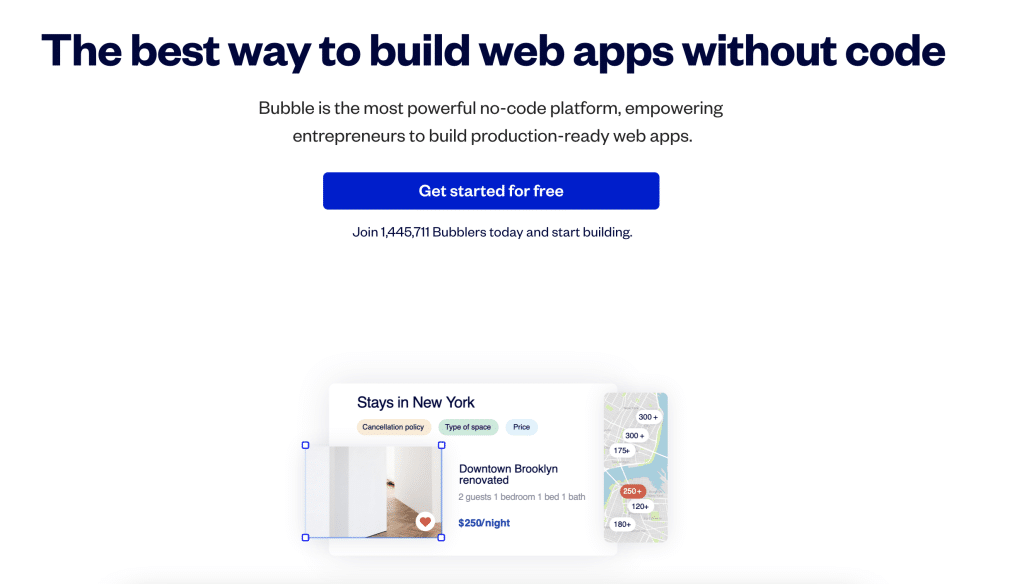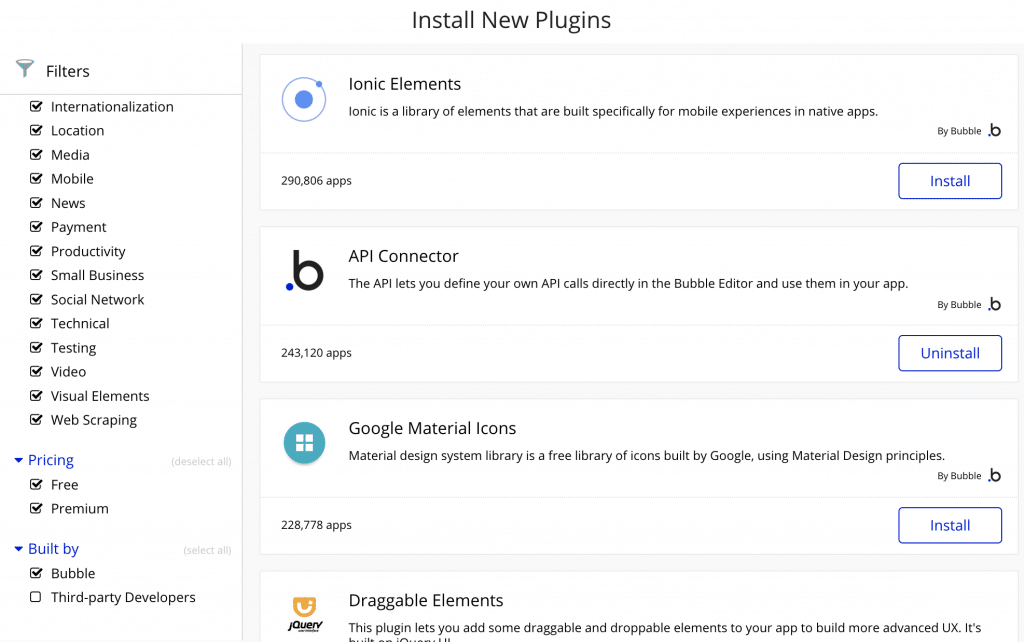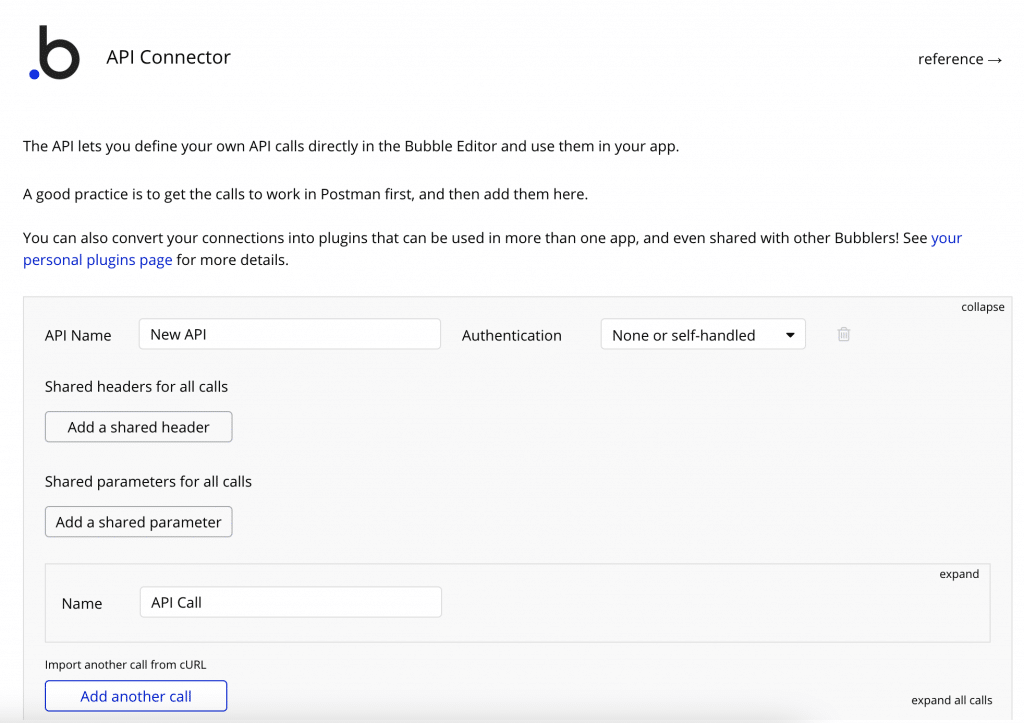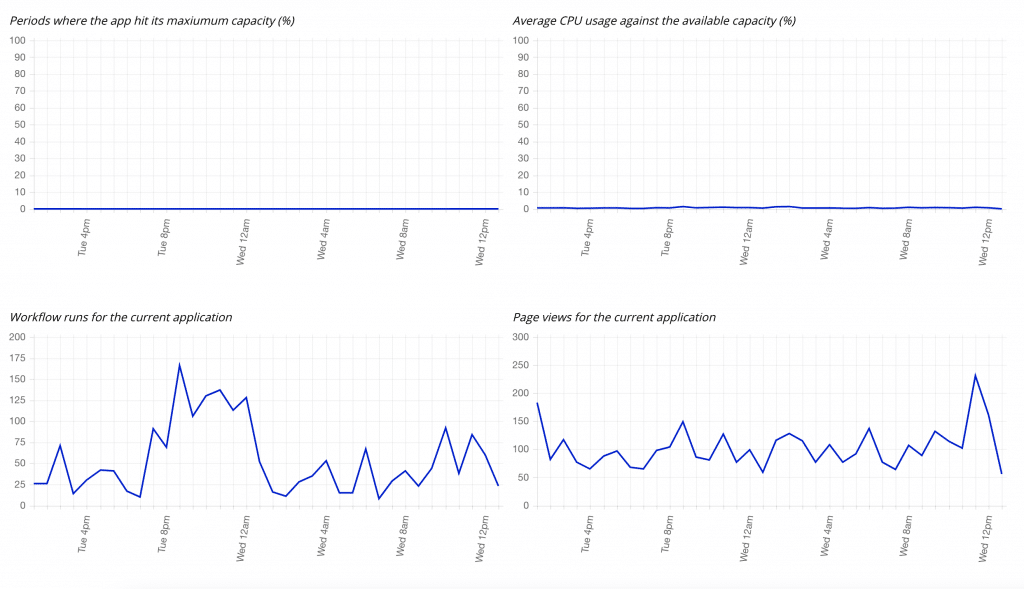In this Bubble review, we’ll establish one thing first: Bubble is changing the way software is built. As the most advanced current no-code platform, it opens up the creation of sophisticated web applications even to people who have no experience with development. But as any other framework, we have to remember that Bubble is a tool. It’s not given that it’s the right tool for every project imaginable.
We’ll try in this Bubble.io review to look beyond the hype to see what Bubble does well, and in what kind of scenarios you may find it’s not a perfect project fit. Is Bubble.io any good? What is Bubble best for?
What is Bubble?
Let’s get this question out of the way first: what does Bubble do? How is it different from website builders like Wix and a CMS like WordPress? (we have a full article comparing Bubble.io with WordPress if you want to dig into it)

The label no-code is actually somewhat misleading. Yes, Bubble does open up the possibility of developing web applications without writing code, but their core mission is actually broader than that: they want to make it possible for anyone to create, host and scale applications without any knowledge on traditional app development and maintenance. How exactly is that different?
In essence, Bubble offers four tools:
- A WYSIWYG page designer and style editor
- A visual workflow editor to add events and actions
- A database hosted in the AWS cloud
- Automatic capacity scaling as the app grows
So Bubble actually takes care of more than just the coding: it attempts to remove any kind of obstacle for a user who wants to create and scale an app, including the actual management of an SQL database, uptime monitoring and capacity upgrades. These are all fields that traditionally require a person or team with separate areas of expertise to develop and maintain. This drastically reduces the cost of development and changes the dynamic for founders that don’t have a development background, allowing them to set up a fully functioning app on their own.
This is all good – low-cost development, no need for a tech team, everything easily scalable – but it brings us to our first important point: Bubble is a walled garden. Every part of your app relies on the Bubble engine to run, meaning that the decision to use Bubble for your project is final. You cannot export your Bubble app – not its design nor its workflows and underlying logic – you’re stuck with Bubble until the day you decide to re-build your project from scratch somewhere else (though you can export your data to move it to another platform).
Bubble apps depend on an active internet connection even to render, as its dynamic pages are prepared on their servers. What you have in the end is not a piece of software native to any operating system, but a browser-based web application that needs to be in constant sync with a Bubble server to function.
Bubble pricing
Remaining on a platform indefinitely means you should be aware of the costs associated with it. Compared to the alternative of hiring a third-party developer, Bubble can be a lot more cost-friendly option, but that doesn’t mean it’s free: each pricing level offers a certain set of features that you may or may not need, but we recommend that you check the pricing comparison page for and up-to-date feature set of each plan.
The final cost of hosting a Bubble app is also determined by a metric called workload. This is essentially a calculation of how much work the Bubble server needs to do in order to keep your app running. This means that you can start out with a fairly low hosting cost, and as your number of users, workflows and database volume increases, the cost will reflect the increased server resource consumption. In other words, Bubble is set up so that you can grow together. You can read more about the workload metric in the Bubble workload documentation.
How difficult is Bubble to learn?
Generally – pretty easy. Setting up your app design and attaching workflows to elements like buttons and input fields is fairly straightforward, making it possible to set up an MVP in the span of a couple of months and faster as you become more experienced. Bubble has invested a lot of resources over the last few years creating a documentation section that helps new users learn the platform, and there’s also a rich ecosystem of courses, boot camps and coaches online.
Bubble’s marketing is focused on ease of use and brands itself as the tool that basically lets anyone build anything fast. While I’m not going to say that’s not true, I think it’s useful to bring a more balanced perspective on it. I’ve seen a lot of new users learning the platform over the years, and the optimism concerning the time frame in which they assume they will get their app to launch is not always helpful.
It will take time – weeks – to learn the basics, and it will take plenty of time – years – to become a great Bubble developer. The phrase easy to learn, hard to master does apply in Bubble’s case. In short, the complexity of your app needs to match your experience level. While it’s perfectly possible to set up a basic working MVP with no experience at all, a more ambitious project will require more experience to build efficiently. Inexperienced developers are sometimes not aware of making basic, but serious mistakes like failing to secure the app with privacy rules.
Any kind of experience you bring into it will of course help: being an experienced designer or having a background working with relational databases will make it easier to grasp how Bubble works, and knowing JavaScript in particular will be helpful since Bubble is built on that framework and inherits a lot of its quirks. That doesn’t mean that it’s a prerequisite to know any of these – only that it might make your venture into no-code easier.
I find a lot of the students I talk to in my Bubble coaching sessions expect their app to be finished within the next four weeks, while in reality it can take months to get it to the finish line as they are learning as they build. This shouldn’t scare you away from using Bubble – but give you a realistic view of the time it does take to set up a high-quality app.
In general, I would suggest spending at least two weeks learning the basics before you start building your project at all. The first weeks will be all about learning the ropes and getting into best practices. You’ll find that setting up an app for the first time will be a pretty quick process, but going back and making changes on something that wasn’t set up the right way to begin with can be time consuming. Working on an app that doesn’t have to be perfect is the best way to approach it with a clean canvas and focus on learning, and you can set up as many pages and explore as many methods as you want without having to remove it later.
Most professional agencies will finish an app in about 4-6 weeks,. They’ll bring experience, preset modules and templates, sometimes multiple developers and detailed project plans into the project to finish it within that time frame. As a beginner, expect to spend at least double that.
But then let’s not forget – that is still a very short time frame for a non-developer to create a fully functioning application.
How much more efficient is Bubble?
Naturally, there’s no absolute answer to this: it depends on what the project is and what framework we’re comparing Bubble with. Generally though – it’s very efficient. Compared with traditional development, Bubble can provide the same result roughly 70% cheaper and 80% faster.
Compared with traditional development, Bubble can provide the same result roughly 70% cheaper and 80% faster
Discussions on Bubble tend to focus on the building of MVP’s and getting them to the market quickly. This is of course true, but an equally interesting angle is that of SME’s being able to leverage technology in a way that historically only bigger companies have had access to.
Using no-code to automate processes, gather data and organize your company can be a game changer for companies who are still living in spreadsheets and never been able to find off-the-shelf software that worked for them. Even a single employee with no-code experience and a sound business understanding will be able to build database systems and automations that can change your business.

Working hands-in directly with the product you want to build also removes the traditional layers where ideas and instructions are lost in translation: as they’re communicated downstream by the project owner to the manager, the designers and finally the developers details change like the whispered sentences in a game of Telephone. Bubble let’s you draw out and test your app directly, without having to explain it to anyone.
It’s very likely that most companies will have some sort of no-code team in the coming years. The edge it gives to have customized technology at a low cost can hardly be overstated.
Bubble’s plugin ecosystem
No Bubble review would be complete without taking a look at how it can expand its features through user-generated extensions. One of the key strengths that made WordPress a household name in internet tech (currently powering more than 75 million websites) is the way in which you can extend a fairly basic set of features with plugins. Bubble follows the same strategy and offers a plugin store that has grown to house a sizeable number of useful additions to Bubble’s features. You’ll find in many cases that there’s a plugin for that when you share a specific challenge on the forum or Twitter, and an increasing amount of the available plugins are built specifically for Bubble.

That being said, the plugin store is not perfect, and its shortcomings deserve some discussion. A legitimate concern shared by many professional developers is that relying on a plugin for key features in your app means placing your trust in a third-party that sometimes you know very little about.
Will they offer customer support? Will they be updating the plugin to stay compatible with Bubble’s engine as it evolves? Will the developer be around for another year? Two? Five? Many plugin builders of course offer high-quality plugins with thorough documentation and fast support – but the plugin store itself has a limited review system, no statistics on bug reports/fixes, developer communication, compatibility or what external libraries they rely on.
These are real concerns, and enough to push numerous agencies to circumvent plugins completely, opting instead to creating their own or solve it in other ways. The good thing is that Bubble opens up for this in several ways that bring less risk, as we’ll explore below.
Connecting Bubble with other services
One of the most frequently asked-about topics we get is whether Bubble will be able to connect to external databases and services, or in the more human jargon: can it speak to my other apps?
In short: yes it can. Bubble has several ways of connecting to third-party services:

The API Connector let’s you set up connections with most kinds of API’s. Rather than building one plugin for each and every API out there, the connector let’s you set up the header, parameter, and call body yourself, opening up the full specter of possible services. If you’re unfamiliar with the term, this means connecting your app to a third-party service to extend the features of your own app. Typical examples include:
- Logging into a website using your Gmail or Facebook account
- Accepting payment with services like Stripe and Paypal
- Getting updated weather reports into your app
- Sharing info between apps, such as pushing a meeting from your CRM to Google Calendar
- Converting currencies with up-to-date rates
These are only a small handful of the possibilities that API’s open up. ProgrammableWeb’s API directory gives an idea of the number of services available, and Bubble’s own webinar video gives a nice explanation into how the connector works.
The API connector let’s you set up the header, parameter, and call body yourself, opening up the full specter of possible services
The plugin ecosystem also includes numerous plugins that do the same thing, but makes the implementation easier. Plugins like Stripe payments adds actions like accepting payments and starting subscriptions to your app without the need for knowing how to set up an API call. Bubble also recently released an updated Zapier plugin, letting you easily set up connections between your apps with simple commands.
The SQL Database Connector let’s you connect with SQL databases and run queries directly from your app. This let’s you set up both actions and pull data, and currently supports PostGres, MySQL and Microsoft SQL.
Bubble’s interconnectedness is one of its biggest selling points: a slow, silent revolution has been going on for years now with apps communicating more and more with each other, and Bubble’s investment into making that easy and flexible places it in the center of that change.
Bubble and performance
The topic of your app’s performance is so widely discussed we decided to write a whole book on the topic. It’s not an easy question to tackle in a review, since performance means a lot of things: everything from page load speed to manipulating huge datasets can be interpreted as performance questions, so there’s simply a limit as to how granular we can get in the span of a review.
As a short Bubble review on performance, we can say that overall Bubble performs quite well. You’ll be able to set up fast-loading pages, manipulate fair amounts of data and can expect it to perform as well as any comparable app within the segment you’re building. Online you may find endless discussions from frustrated builders who struggle in getting the performance they would have liked from their apps, but in most cases this is the result of their own inexperience in building, not Bubble. Bubble’s flexibility comes at a price: you’re perfectly allowed to set up your app in very inefficient ways, and in most cases inexperienced developers are not aware that they’re doing it.

Still, there are areas where Bubble does leave room for improvement, that may or may not be relevant to your app. We’ll try to list some of the most important ones in the hope that they can provide a hint as to where you should direct your research before settling on Bubble:
- Working with big amounts of data (millions of records) can put Bubble to the test. Searching through them can work well in many cases if the database is properly structured, but making frequent changes on large volumes of data can push Bubble to the limits of its performance
- Bubble’s page rendering is generated server-side, leading to an always-present slight delay on page load that you as a developer can do nothing about. Bubble currently doesn’t support any kind of caching of static HTML files (like WordPress plugins can do), meaning that you do rely on Bubble to serve it up as quickly as it can. Again this is mostly up to the developer to set up efficiently – but at some point you will meet the limits of the underlying technology, and it’s out of your hands to change that
- The way CSS is currently applied in-line to page elements in your app also adds to the page rendering not being as efficient as it could be. The ongoing updates to the responsive engine will address this to some extent, but as of now, the Styles section simply is not as efficient as CSS would be
- The way the visual editor is structured also means that showing big amounts of data on the screen at the same time can put serious pressure on your device as the number of DOM elements grows into the thousands. Building a data-heavy visual tool like Google Spreadsheets would not be easily done in Bubble as of now.
Bubble’s future
In any proper Bubble review, we’ll also have to focus on what the platform will be like in the future. As we’ve established, Bubble is a lock-in platform that hosts all apps on its own cloud servers. This let’s you develop, host and scale apps with ease, but it also means the future of your app is tied to Bubble’s future. The company has made a promise to open source their technology should they ever be in a position that forces them to go out of business.
That being said, there’s no real way of predicting just what Bubble’s future will look like. Them going out of business seems unlikely – the quality of the product, loyalty of its users and current growth is simply too promising to expect that. What’s harder to predict is how Bubble’s future will be shaped by future investors and a possible acquisition. No-code at the time of writing this review has caught the attention of a serious volume of users – Bubble.io crossed one million registered users just a week ago. Markets of course function in a predictable way: companies rise and fall, merge and are acquired until a few remain. Groundbreaking innovation is often brought to the market by newcomers hungry to change an industry. No doubt the no-code movement has caught the attention of the current biggest sharks in the online ocean like Microsoft, Amazon and Google.
How do they usually react? They open up their wallets and buy their way to dominance in yet another sector.
Is that what the future holds for Bubble? There’s no way to tell, but having worked with the tech startup scene for a number of years now, I know that the promises made by founders in a company’s early years often don’t reflect they direction they take as they’re swallowed up by the enormity of the market they are changing. Instagram, WhatsApp, Linkedin and Youtube were all independent companies until one day they became part of the portfolio of one of the internet giants.
Now that begs the question of course – is that a bad thing? Not necessarily. Should Bubble become an Alphabet, Softbank, Amazon or Microsoft product, that could bring resources, experience and scale that benefit its users in many ways. It could make the platform better for all we know.
The point is not that we should fear a possible acquisition, but to take into account as you make your decision that Bubble is still a startup that holds a future we can’t predict with certainty.
Bubble.io review Conclusion
So let’s wrap up our Bubble.io review. We’ve worked with Bubble since 2016, and the dialogue surrounding no-code has changed drastically over these years. It has moved from a niche interest to a widely discussed ongoing revolution in how software is built, and it’s not due to rumors or hype, but can be summed up in a basic calculation: if you could build professional software 70% cheaper and 80% faster, why wouldn’t you?
A 70% cost reduction is a big deal for any company: startups can get their product to the market without investors. SME’s can build custom software to streamline their processes, and companies of all sizes can take an idea or experiment to the live market with paying users in the span of a few weeks.
Bubble is the most advanced platform out there at the time of writing, but it’s important to know what it is and what it isn’t before deciding to take on a major project: Bubble is a platform for building browser-based web applications that rest on top of a database. It requires a constant internet connection to work and you are locking yourself in: you cannot export the design or workflows of your app. You are relying on Bubble and any plugins that you use to still be around next year for your app to work.
Still, there’s little doubt that the no-code revolution has come, and is on the verge of exploding. Getting on that train early and gaining experience before it really takes off can’t be a bad thing. The low entry threshold means you’ll be building an app within a few weeks, and can consider yourself a professional builder in a few months, whether you’re offering that service to clients or working on your own projects.
Whether Bubble fits a particular project depends on the nature of it, and I hope we’ve been able to provide a balanced view for you to make an informed decision. If you’re simply curious about what Bubble can do, there really is no reason to get to know it. Signing up to Bubble is free, and that plan let’s you play around until you’re ready to tackle the more advanced feature – and it just might change your career.








5 Comments
Quick typo!
“basically let’s anyone”
should be
“basically lets anyone”
Go ahead and remove this comment when it’s fixed or if you don’t care either way.
Thanks Julian, fixed!
Great article Pettter – well considered and written!